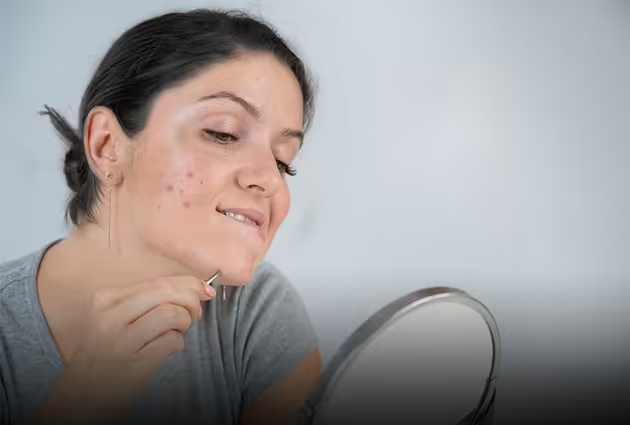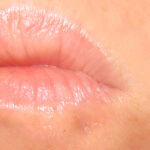Individuals who have conditions like thyroid or PCOS often deal with excessive hair growth, leading them to seek hair removal methods like plucking. While plucking might offer a temporary solution, it is important to note that excessive and aggressive plucking can damage the skin. On the other hand, it might also have minimal repercussions if done gently. This article delves into the occurrence of dark spots on chin due to hair plucking.
Many women endure the discomfort of hair removal only to be confronted with another challenge: dark spots or marks on their skin. This aftermath is particularly prevalent among women with darker skin tones who resort to plucking, resulting in noticeable spots on their chins.
If you’ve noticed dark spots after a hair plucking session or are grappling with hyperpigmentation, it’s crucial to understand the underlying causes. In this article, we’ll explore what these dark spots are and the most effective strategies to address them.
Can Plucking Chin Hair Cause Dark Spots?
For many women, plucking chin hair is a common grooming routine. However, a concerning aftermath of this process is the appearance of dark spots. But what causes these spots, and are they directly linked to tweezing?
When you tweeze chin hair, it doesn’t just remove the hair. The act also exerts stress on the skin, damaging skin cells, and uprooting the hair from its follicles. This process can be particularly traumatic if done frequently or aggressively. Moreover, the skin’s innate sensitivity level can play a role in determining the severity of discoloration or hyperpigmentation post-plucking.
But what exactly is hyperpigmentation? It’s a skin condition arising from the overproduction of melanin, the pigment responsible for skin and hair color. Various factors can trigger this overproduction, such as UV rays, acne, insect bites, and, notably, physical trauma like plucking. Thus, many women observe dark spots following waxing or tweezing sessions.
The plucking action, especially if not done correctly, increases the chances of ingrown hairs. These are hairs that, instead of growing outward, curl and grow back into the skin. This not only causes discomfort but also disrupts the skin’s cellular structure. In attempts to rid of these ingrown hairs, many people end up causing further injury to the skin.
This added irritation and damage enhance melanin production, culminating in the appearance of dark patches. So, in essence, while plucking might seem like a quick solution for unwanted chin hair, it can lead to unintended skin issues, including persistent dark spots.
How to Remove Dark Spots on Chin Due to Hair Plucking?
The appearance of dark spots on the chin after hair plucking is an issue many contend with. Termed hyperpigmentation, these spots can be intensified by factors such as direct sun exposure. Ensuring you protect yourself from UV radiation becomes paramount to mitigate this.
Prioritizing Sun Protection:
Regular application of a high-factor sunscreen, like SPF 50++, even on overcast days, is vital. With UV radiation being a primary accelerator of hyperpigmentation, diligent sun protection can substantially prevent the dark spots from becoming more pronounced. A lack of sun protection can open the door to various skin problems, including accentuated hyperpigmentation.
The Role of Exfoliation:
The connection between ingrown hairs and dark spots underscores the importance of exfoliation in skincare. Exfoliating, especially before hair removal, minimizes the chances of ingrown hairs, which are a known precursor to dark spots. Adopting a weekly regime that incorporates chemical exfoliants can peel off the skin’s top layer, leading to a gradual reduction in these spots.
Harnessing the Power of Niacinamide:
Niacinamide has proven to be an effective agent against hyperpigmentation. It has displayed a marked ability to treat dark spots, especially those resulting from hair plucking. Studies involving the topical application of a 4% Niacinamide solution have shown significant improvements in hyperpigmentation within nine weeks. Moreover, Niacinamide can also address acne scars and other skin discolorations, contributing to comprehensive skin health.
Laser Treatment: A Solution for Stubborn Scars
For those battling permanent scars resulting from hair removal, laser treatment emerges as an effective remedy. Certain scars, which might resist traditional treatments, can be effectively treated with targeted laser procedures. Various laser modalities, especially CO2 lasers, can work wonders in addressing dark spots and persistent scars.
Chemical Depilatories: An Effective Hair Removal Alternative
Chemical depilatories, available in forms like lotions, provide an alternative to traditional hair removal methods. They chemically break down unwanted hair, offering a longer-lasting solution compared to shaving. Their usage can also reduce the chances of dark spots. However, a preliminary patch test is essential to ensure no adverse skin reactions.
Understanding the Implications of Plucking Hair
Plucking stands as one of the commonly employed techniques for removing unwanted hair, especially those on the chin. While it offers the immediate gratification of hair-free skin, it is surrounded by a cloud of myths, with one of the most prevailing ones being the regrowth of thicker hair post-plucking.
Plucking works by pulling out hair from its root, which is embedded deep within the hair follicle. Over time, with repeated plucking, these follicles can become damaged or even destroyed. This means that hair might either grow back thinner or, in some cases, might not grow back at all. However, this repeated trauma to the skin and the follicle can result in skin irritations, such as redness or swelling post-plucking.
Therefore, while plucking can offer a quick and seemingly effective solution, it might not be the most sustainable or skin-friendly method for hair removal in the long run. It’s essential to weigh the immediate results against the potential long-term implications on the skin and hair growth.
Preventing Ingrown Hairs and Healing Skin After Tweezing
1. Embrace the Power of Mandelic Acid:
Mandelic acid is a potent alpha hydroxy acid (AHA) derived from bitter almonds. Applying a serum that contains mandelic acid can enhance cell turnover, ensuring that dead skin cells don’t accumulate and block hair follicles. This reduces the likelihood of ingrown hairs forming after tweezing or shaving.
2. Master the Art of Shaving:
When you decide to shave, it’s essential to employ techniques that minimize skin damage and the risk of ingrown hairs.
- Prep the Skin: Always wet the skin before shaving to soften the hair and reduce friction.
- Choose the Right Products: Using a moisturizing shave cream or gel can provide a protective barrier between the razor and your skin, allowing for a smoother shave.
- Shave in the Right Direction: Instead of going against the grain, always shave in the direction of hair growth. This reduces the chances of the hair curling back into the skin.
- Avoid Shaving Too Closely: Ultra-close shaves might look and feel smoother initially, but they increase the risk of hair growing back into the skin.
3. Opt for Electric Razors:
Electric razors can often provide a less aggressive shave compared to traditional razors, reducing the risk of skin irritation and subsequent ingrown hairs.
4. Incorporate Exfoliating Ingredients in Your Skincare Routine:
If you notice dark spots or pigmentation due to skin damage from tweezing, turn to skincare products that boost cell turnover.
- Mandelic Acid: Known to exfoliate the skin gently, making it suitable for even sensitive skin types.
- Vitamin A: Also known as retinoids or retinol, these compounds can accelerate cell turnover and reduce pigmentation.
- Lactic Acid: Another AHA, lactic acid exfoliates the skin and helps in lightening dark spots.
- Glycolic Acid: A potent AHA, it effectively exfoliates the skin and is often used in dark spot treatments.
By incorporating these preventive and healing measures into your skincare routine, you can significantly reduce the occurrence of ingrown hairs and improve skin damaged by tweezing.
Final Thoughts
Understanding the link between hair plucking and dark spots on the chin is essential for proactive skincare. This article has highlighted the main causes, especially the role of ingrown hairs. To prevent such issues, maintain a clean, moisturized, and exfoliated skin routine. As you address hair removal, always approach it gently and patiently to keep your skin at its best.
Medical Disclaimer: This article is for informational purposes only and is not a substitute for professional medical advice or treatment. Consult your physician before making any decisions related to your health.
Disclaimer: The content on Wellness Derive is for informational purposes only and not a substitute for professional medical advice, diagnosis, or treatment. Always consult a healthcare provider for medical concerns.



